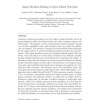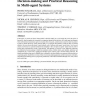JAIR
2011
13 years 10 months ago
2011
Markovian processes have long been used to model stochastic environments. Reinforcement learning has emerged as a framework to solve sequential planning and decision-making proble...
AI
2010
Springer
14 years 1 months ago
2010
Springer
Computer systems increasingly carry out tasks in mixed networks, that is in group settings in which they interact both with other computer systems and with people. Participants in...
LOGCOM
2002
14 years 3 months ago
2002
paper, we present an abstract formal model of decision-making in a social setting that covers all aspects of the process, from recognition of a potential for cooperation through t...
JIPS
2007
14 years 3 months ago
2007
: Mobile technology appears promising as a method to promote group performance in circumstances dependent on time, but not member proximity. However, the success of mobile technolo...
ANOR
2005
14 years 3 months ago
2005
: In this paper, we present a supply chain network model with multiple tiers of decision-makers, consisting, respectively, of manufacturers, distributors, and retailers, who can co...
DSS
2008
14 years 3 months ago
2008
Previous research indicates that the human decision-making process is somewhat nonlinear and that nonlinear models would be more suitable than linear models for developing advance...
AAAI
1997
14 years 5 months ago
1997
Mixed-initiative planning is one approach to building an intelligent decision-making environment. A mixedinitiative system shares decision-making responsibility with the user such...
WSC
2001
14 years 5 months ago
2001
Modelling human interaction and decision-making within a simulation presents a particular challenge. This paper describes a methodology that is being developed known as `knowledge...
SPIRE
1999
Springer
14 years 7 months ago
1999
Springer
One resource playing a critical role in electronically supported decision-making groups is the facilitator. Facilitation is a complex task, encompassing social abilities, pre-meet...
HICSS
2003
IEEE
14 years 9 months ago
2003
IEEE
The effective management of knowledge is critical for organizations that are striving to gain or maintain a competitive advantage and that are in the process of re-structuring for...






